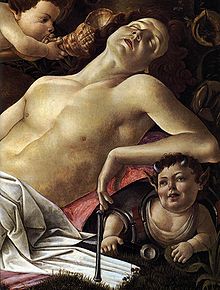Venus and Mars (Botticelli)
Venus and Mars is a painting by Sandro Botticelli that was created around 1485. It has been in the National Gallery in London since 1874 (inventory no. NG 915). The panel is one of the most important testimonies to the artistic change in Florentine painting in the late 15th century, which reflects the development from an emphatically bourgeois to a courtly culture.
history
Little is known about the provenance and date of creation of the picture. In art history it is generally assumed that it was made after Botticelli's return from his stay in Rome in 1482, and that his study of ancient sarcophagi with their nudes had a related influence on the figure of Mars. The picture can be seen in connection with other pictures from this epoch, in which he deals with mythological topics, such as The Birth of Venus , Primavera or Minerva and Centaur .
From the format and dimensions of the picture it can be concluded that it is a Spalliera - or a Cassone picture , with which the wedding chests of women of the Florentine society were furnished. The wasps (it. = Vespe ) in the upper right corner above the head of Mars could give a possible reference to the commissioner of the picture as an allusion to a wedding in the Florentine house Vespucci , with whom Botticelli was friendly.
A topographical indication of a connection with Florence is the city depicted in the blue haze in the distance with the dome of the Florentine cathedral.
Image description
In the landscape format painting, an elegantly dressed woman is lying in a meadow. She supports herself with her right arm on a red silk pillow, the left hand rests relaxed on her thigh. Opposite her lies a naked young man in a deep sleep. His loins are only loosely covered by a white cloth. The couple is surrounded by satyr children who play with the man's discarded weapons and a conch shell .
Shown here in a symmetrical arrangement are Venus and Mars , the famous mythological lovers after the act of love, as described by Reposianus (3rd / 5th centuries AD) and other ancient writers. Venus is dressed in a flowing white robe, which is lined with gold braids and richly decorated. At the neckline she wears a gold brooch made of a gemstone surrounded by pearls, which fixes the two thin braids of her hairstyle that fall down on her chest. Strands of strands have come loose from her blonde hair, artfully tamed with braids, which fall in ringlets on her chest and shoulders. Mars lies in a deep sleep on his red cloak, his mouth is slightly open, his heavy head is leaned far back against a tree trunk, leaving his neck and throat completely defenseless. Myrtle bushes and branches of myrtle grow to the heads of the two people , which in ancient mythology were consecrated to the goddess Aphrodite and with which the bride has been adorned at wedding since ancient times. A flock of wasps buzzes out of the hollow tree at the head of Mars. In the background there is a view of a wide landscape with a city silhouette and a mountain range on the horizon.
Mars , the god of war, has been overcome by Venus , the goddess of love. Deprived of all weapons, carried by the fauns in the middle distance and portrayed as a nude figure, he embodies the "ideally beautiful" far from any defensiveness. Venus, on the other hand, is richly dressed like a young lady from a noble house and thus largely withdrawn from the realm of the erotic.
Interpretations
The picture can be interpreted as an allegory of the pacification of warlike action through love. Love, understood as a spiritual power in the sense of Plato , has overcome the horrors of war and violence: Venus tamed Mars, love has triumphed over violence. Ancient philosophy and Christian understanding of the world are linked in the Neoplatonic philosophy, which was cultivated in the Medici Florence, as Botticelli illustrates in his picture.
reception
In the composition of his picture Venus, Mars and Amor , Piero di Cosimo , also a Cassone or Espalliera picture, created around 1505 in Florence, is based heavily on Botticelli's pictorial invention. In Botticelli, however, all allusions to the love fraud of Mars and Venus, as told by Homer in his Odyssey , and which has become a frequently narrated subject in Western art, are missing .
literature
- Manfred Wundram : Painting of the Renaissance. Edited by Ingo F. Walther. Benedikt Taschen Verlag, Cologne et al. 1997, ISBN 3-8228-8194-5 , p.
- Hannelore Vorteilmann: Everyday life and celebrations. Florentine cassone and espallier painting from the time of Botticelli (= pictures in focus. ). National Museums in Berlin - Prussian Cultural Heritage, Berlin 2000, ISBN 3-88609-294-1 .
- The late mythological images. In: Frank Zöllner : Botticelli . Beck, Munich 2009, ISBN 978-3-406-59112-9 , pp. 80-91.
Web links
- Venus and Mars at the National Gallery



